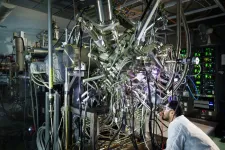Experimental drug NU-9 — a small molecule compound approved by the U.S. Food and Drug Administration (FDA) for clinical trials for the treatment of amyotrophic lateral sclerosis (ALS) — improves neuron health in animal models of Alzheimer’s disease, according to a new Northwestern University study.
Like ALS, Alzheimer’s disease also results from misfolded proteins that damage brain health. Rather than treating symptoms from specific diseases, NU-9 instead addresses the underlying mechanisms of disease. Results from the new study give scientists hope that the drug should demonstrate effectiveness in the common mechanisms that give rise to multiple neurodegenerative diseases.
“This drug is quite remarkable that it works in these multiple systems,” said Northwestern’s Richard B. Silverman, who invented NU-9. “We need to test it in humans before we know how effective it is in treating Alzheimer’s disease. But how well upper motor neurons function in mice is similar to how well they function in humans. So, it seems to me, NU-9 really should work.”
The study was published last month (March 3) in the Proceedings of the National Academy of Sciences. The paper demonstrates the drug’s efficacy in cellular cultures and a small mouse study.
“What our study demonstrates is that the same mechanism affects two totally different proteins in two totally different diseases,” said Northwestern’s William Klein, the study’s co-corresponding author. “In both diseases, cells suffer from toxic protein buildup. It appears there is a common mechanism that gets rid of these proteins to prevent them from clustering. NU-9 is rescuing the pathway that saves the cell. It’s very exciting.”
Silverman, who previously invented pregabalin (Lyrica) to treat fibromyalgia, nerve pain and epilepsy, is the Patrick G. Ryan/Aon Professor of Chemistry at Northwestern’s Weinberg College of Arts and Sciences and founder of Akava Therapeutics, a startup company which is commercializing NU-9. An expert on Alzheimer’s disease, Klein is a professor of neurobiology at Weinberg and cofounder of Acumen Pharmaceuticals, which has a therapeutic monoclonal antibody to treat Alzheimer’s disease currently in clinical trials.
In patients with neurodegenerative diseases, misfolded proteins clump together inside brain cells. This accumulation of misfolded proteins leads to toxicity that disrupts normal brain function and eventually triggers brain cells to die. While misfolded SOD1 proteins (among others) cause ALS, misfolded amyloid beta oligomers cause Alzheimer’s disease.
“These are good proteins gone bad,” Klein said. “They are good proteins, but when they clump together, they play a role in their own build up. They stick to the cells, to the nearby cells and to the synapses. That causes brain dysfunction and, ultimately, brain cell death.”
In previous studies, Silverman and longtime collaborator P. Hande Ozdinler, an associate professor of neurology at Northwestern University Feinberg School of Medicine, discovered that NU-9 helped cells remove the protein clumps caused by two unrelated mutated proteins to restore neuron function in animal models with ALS. Silverman and Klein wanted to explore whether NU-9 might have a similar effect on Alzheimer’s disease.
To conduct the new study, the team started with cultures of neurons from a small animal model. In one experiment, the scientists added a form of amyloid beta to these cells. The amyloid beta oligomers quickly formed and stuck to cells. In another experiment, the scientists treated the cells with NU-9 before adding the amyloid beta. NU-9 reduced the amount of protein buildup within the cell and along the cell’s branches, or dendrites. Even after the researchers removed NU-9 from the treated cells, the drug still had a lasting, protective effect.
After demonstrating NU-9’s success in cell cultures, the team tested its effectiveness in a whole animal model. They administered an oral dose of NU-9 to a mouse model of Alzheimer’s disease and found the animals’ performance on memory tests improved. In promising follow-up studies, the team also found NU-9 reduces brain inflammation associated with Alzheimer’s disease.
“Inflammation of the brain was prevented or greatly reduced by the treatment of NU-9,” Klein said. “It stops the amyloid beta oligomer buildup, and also stops the consequences of neuroinflammation, which causes a lot of damage in the brain. So, the drug is very powerful on two levels: cellular and whole animal.”
Although the researchers are still trying to fully understand how NU-9 works, they made some key discoveries. They found NU-9 specifically prevents the buildup of amyloid beta oligomers that form inside cells but doesn’t prevent these proteins from forming outside cells. This means NU-9 must be working on a process within the cell to prevent harmful protein clusters.
After further analysis, the researchers found the drug relies on lysosomes, which are one of the cells’ major recycling centers, and on an enzyme called cathepsin B. In Alzheimer’s disease, this recycling system is disrupted, causing amyloid beta to accumulate. NU-9 might help move amyloid beta proteins into the lysosomes, where cathepsin B then helps break down the protein clumps.
“Cells have two important ‘junk compartments’: the lysosome and the proteasome,” Silverman said. “They collect junk and other components that are not useful to the cell, chew them up and get rid of them. We found the proteasome wasn’t involved at all. It’s the lysosome that plays a role in how NU-9 works. But we’re still trying to figure out exactly what NU-9 binds to in order to trigger the lysosome.”
“It’s a black box phenomenon,” Klein added. “It’s like a relay race for moving these toxic clustered proteins around the cell. The proteins are clustered in one vesicle and then another vesicle and then finally handed off to the lysosome. We think NU-9 targets something in the early stage of that relay, but we don’t know exactly what the target is.”
Although the results are promising, the researchers say there is still a long road ahead. Klein emphasizes the need for more rigorous memory testing with the animal models. And Silverman aims to further refine the compound to make it even more effective.
The team also plans to explore the effectiveness on NU-9 in other neurodegenerative diseases, like Parkinson’s disease and Huntington’s disease.
“It has long been thought that every neurodegenerative disease is a completely separate disease, but our findings suggest that common mechanisms might connect them,” Silverman said. “This discovery opens the door to a new family of therapeutic compounds that, like NU-9, could control multiple degenerative diseases at a point before major damage to cells begins.”
The study, “Inhibition of amyloid beta oligomer accumulation by NU-9: A unifying mechanism for the treatment of neurodegenerative diseases,” was supported by the National Institutes of Health (grant numbers AG061708 and AG050492) and the Chemistry of Life Processes Institute (grant number 2T32GM15538).
END




